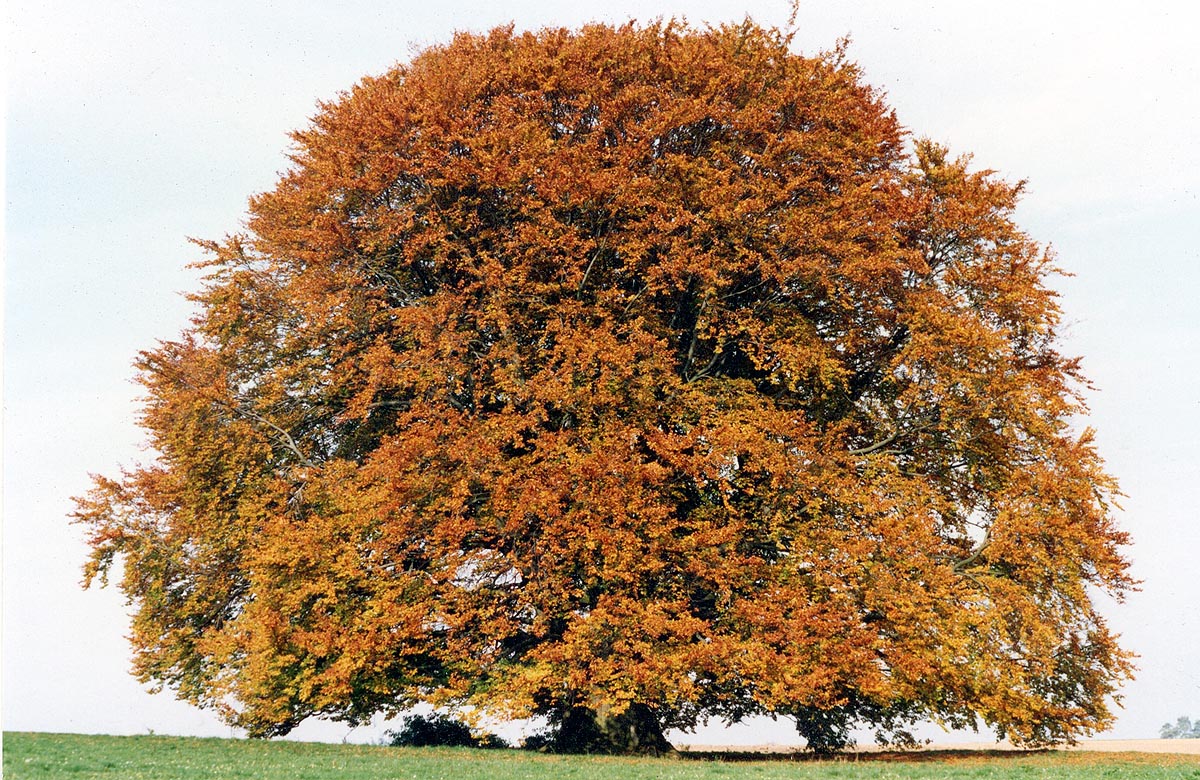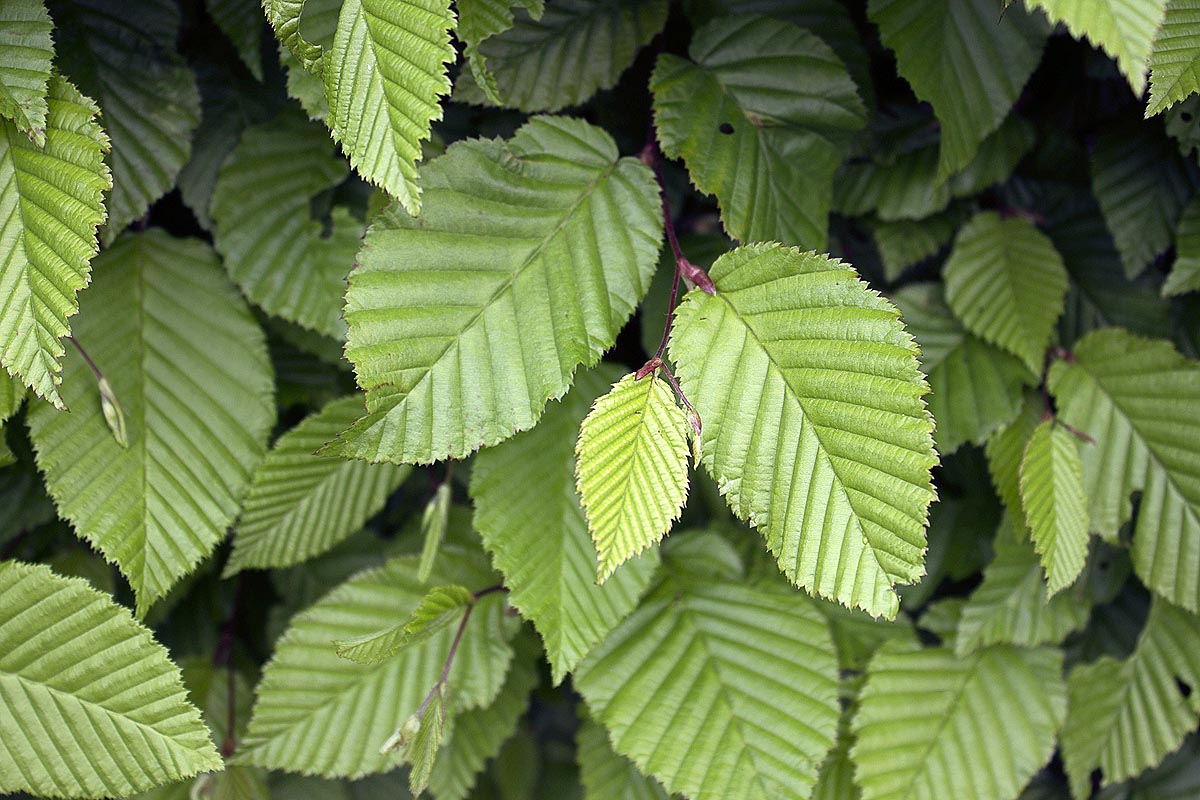The American beech is the majestic mother of the forest. Best appreciated as a solitary tree they can reach 90 feet (27m) tall and live for over 300 years. Solitary specimens have low branches so little grows beneath them but it does make the tree so much more elegant. Single trees are not for small gardens but they can be grown closer together to create beautiful forests. This tree is one of the most important in a forest at the nuts it produces are depended upon by almost all the creatures that live there from chipmunks to black bears as well as over 100 insect species and the birds that come to feed upon them. Lovely trees for shade and forest growth the nuts are also collected and eaten by people and were a main staple in earlier times. Beech don't take well to transplanting so starting from seed and planting early is the best way to grow your own beautiful beech tree either single or in a forest.
Beech trees are easily identified by the light gray smooth bark making them very attractive but also prone to individuals carving them. Its usual to find an un-carved beech in a public forest or park only in private locations cab the beauty of the bark still be seen.
Beech trees also have very distinctive winter buds which are long, thin and rusty brown in color. Resembling little pointed spears they are usually about 3/4 inch (1.8cm) long.
Leaves are arranged alternately on the stems with only one leaf per node. They are spear shaped, broadly oval with sharp point and serrated along the margins. Leaf veins are deeply set and the leaves seem almost corrugated In early spring the leaves are light bright green and contrast wonderfully with the gray trunks. As they mature they become shiny and turn a darker green on the upper surface and lighter beneath reaching 3-6 inches (7.6-15cm) long and 1-2 inches (2.5-5cm) wide. In fall they turn light rusty brown color and in some cases can persist on the tree throughout the winter. It is rare that a beech looses all its leaves before spring.
Flowers appear shortly after the leaves begin to emerge and often go unnoticed. There are male and female flowers. The male flowers are tiny about 1/8" (3mm) but arranged in globular clusters about 1 inch (2.5cm) in diameter and consist of groups of 4-8 green stamens in a hairy calyx. Flower globes hang from thin stems about 2 inches (5cm) long and occur in clusters from the leaf node. Female flowers are borne on smaller much stouter stems and occur in pairs embedded in a body of hairy scales and pinkish red bracts. Each flower is about 1/4 inch (5mm) long consisting only of 4-6 narrow calyx lobes and a pistil with 3 styles. Wind pollinated the flowers bloom for about a week ending before the leaves reach larger sizes which could block pollen movement.
Flowers are followed by nuts that occur in pairs in prickly husks up to one inch (2.5cm) long. These are initially green ripening to brown when they spilt open to drop their two triangular shaped nuts. Trees fruit and produce nuts about every 4-6 years.
All our seeds are cold stored so they already have the idea of winter. However they still need a period of moist stratification before they will germinate. Seeds should be kept in the refridgerator until ready to be dealt with. There are several different methods that can be used to stratify seeds please see our Stratification instruction to determine which method is best for your needs.
Beech trees need a moist stratification period of about 90 days. Sow as deep as the seed is tall. So if the seed is 1/4 inch (5mm) plant that deep.
Plant seeds in large enough containers to allow them to sprout and produce roots. Often trees produce roots well before a shoot is seen so give them enough depth and plant in either in individual pots or in pairs so as not to disturb any non germinated seeds when transplanting.
After seeds have germinated and have their first set of leaves carefully move them to larger individual pots. Give them good light. If supplemental light from grow lights and a longer day length are provided the trees will grow faster and taller. Move to larger pots as required taking care not to disturb the roots. Trees should be grown in tree pots which are deeper than regular pots but cardboard milk or juice containers are ideal for this purpose. We do not recommend plastic containers as it is more difficult to remove the plant from the pot without damaging it. Cardboard ones can be pealed away or just left to decompose themselves. Make sure to punch a few holes in the bottom of the container for drainage before you plant. (its much harder and messier to do it after its planted).
Nurse tree seeds along until they are at least 12 inches (30.5cm) tall. Ensure they are kept in semi shade not in bright outdoor sunlight as beech seedlings do not do well in bright light (they are used to understory shade when germinating normally). Ensure you gradually introduce your tree(s) to bright sunshine and only then consider planting outside.
If planted close together to form a 'forest' trees tend not to have low branches but understory still tends to be mostly open. Again little extra effort is required for maintenance.
Young beech trees need shade, they are used to growing in dense understory and don't take to bright sunshine well until at least 12-14 inches (30-35cm) tall. Ensure all very young trees are protected from bright sun using shade tubes or some other kind of cover. Once established does very well in full sun and grows quickly to begin with before settling down to a more sedate growing pace.
Once established it will grow towards the strongest light source so ensure it has an even source or the tree will grow distorted towards the light. Beech trees are very long lived 300 years is not uncommon.
If intending to plant a new forest consider mixing beach with other tree species. Most trees do best in a mixed woodland.
Beech needs a well drained soil preferably with rich organic material. Will not tolerate wet poorly drained soils at all, so not suitable for heavy clay. However it will grow on most well drained soils and even shallow soils like mountainsides but some soil cover is needed not recommended for rocky hillsides. Some reports state it does well in acid soils while others claim its best on chalk which is alkaline, so it probably does well on any kind of soil. However very strong acid or alkaline is most likely not advisable.
Beech has a shallow root system so it not good along paths or roads. Its roots are very wide to compensate for depth in order to keep the tree solidly in place and since trees can survive for over 300 years its pretty effective.
However it wont cope well with its roots being disturbed by construction of any kind that may destabilize the tree they need a wide area of their own. They also need uncompacted soil so running heavy equipment over the ground near a tree can cause it to go into decline.
Beech are cold hardy and can tolerate temperatures down to -22 F(-30 C) and is not very salt tolerant so not a tree for the seashore or close to a road that will be winter salted.
Most important are the beech nuts or beech mast that are depended upon by almost all the animals that live in a forest from the smallest chipmunk up to black bears which use the beech nuts as important food to get them through the winter months. Every animal comes to feed on the beech nuts. Some research has suggested that the now extinct Passenger Pigeon owed much of its success to feeding on beech nuts and roosting in its branches. Its certainly THE tree to grow if you want to help the wildlife.
Mature beech trees can produce massive amounts of beech nuts once they mature. Nuts usually form every 4-6 years and mature trees can produce literally tons of nuts with different trees producing in different years the forest animals stay well fed ready for winter.
Beech nuts. Like the forest animals humans have long eaten the nuts too. They can be eaten raw although many sources suggest only in limited quantities as they can cause upset. Nuts are very nutritious and contain oils and about 22% protein.
Cooked they are eaten in quantity and some parts of the United States and Canada they are sold in farm markets. They can be dried and ground into a powder which is then mixed with cereal flours and used in baking. They roasted and eaten whole or ground and used as a coffee substitute. Fresh nuts can also be pressed to extract the oil used in cooking like olive oil.
The inner bark of the tree is also dried and then used as a thickener for soups and etc or mixed with flours in baking.
Fresh beech nuts are reported to help remove gut parasites.
The wood is much prized. It is strong and mostly white in color and used to make toys, cookware, tool handles, chairs and other furniture and flouring as well as for barrels for aging beer.
Wood can also be distilled to obtain alcohol and creosote. It is also excellent for making charcoal.
While not the same species the European beech appears to have been the first 'paper'. The earliest Sanskrit characters were carved on strips of Beech bark and this practice moved through Europe with the first written items being on beech bark.








